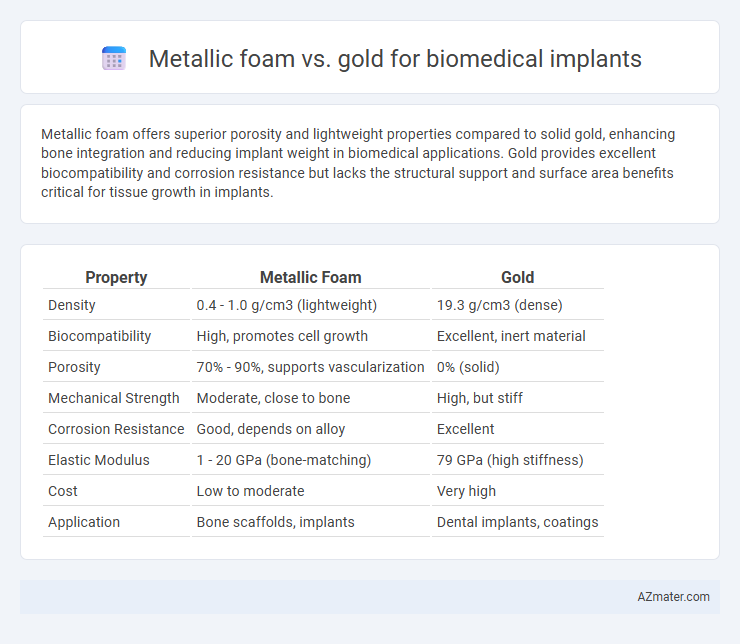Metallic foam offers superior porosity and lightweight properties compared to solid gold, enhancing bone integration and reducing implant weight in biomedical applications. Gold provides excellent biocompatibility and corrosion resistance but lacks the structural support and surface area benefits critical for tissue growth in implants.
Table of Comparison
| Property | Metallic Foam | Gold |
|---|---|---|
| Density | 0.4 - 1.0 g/cm3 (lightweight) | 19.3 g/cm3 (dense) |
| Biocompatibility | High, promotes cell growth | Excellent, inert material |
| Porosity | 70% - 90%, supports vascularization | 0% (solid) |
| Mechanical Strength | Moderate, close to bone | High, but stiff |
| Corrosion Resistance | Good, depends on alloy | Excellent |
| Elastic Modulus | 1 - 20 GPa (bone-matching) | 79 GPa (high stiffness) |
| Cost | Low to moderate | Very high |
| Application | Bone scaffolds, implants | Dental implants, coatings |
Introduction to Biomedical Implant Materials
Metallic foam and gold represent two distinct categories of materials used in biomedical implants, each offering unique advantages in biocompatibility and mechanical properties. Metallic foam provides a lightweight, porous structure that promotes osseointegration and tissue in-growth, enhancing implant stability and reducing stress shielding. Gold, valued for its excellent corrosion resistance and biocompatibility, is primarily utilized in applications requiring high resistance to bodily fluids and minimal inflammatory response.
Overview of Metallic Foam in Implants
Metallic foam in biomedical implants offers a unique combination of high porosity, low density, and excellent biocompatibility, promoting osseointegration and reducing implant weight. Its porous structure mimics natural bone, enhancing nutrient flow and tissue in-growth essential for long-term implant stability. Compared to solid gold, metallic foam provides superior mechanical compatibility and reduced stress shielding, making it a promising material for orthopedic and dental applications.
Gold as a Traditional Implant Material
Gold has long been valued in biomedical implants for its exceptional biocompatibility, corrosion resistance, and stability within the human body, making it a traditional material in dental and cardiovascular applications. Unlike metallic foams, gold offers superior resistance to oxidation and biological degradation, ensuring longevity and minimal adverse tissue reactions. Despite its high cost and limited mechanical strength compared to newer materials, gold's inertness and ease of fabrication continue to make it a preferred choice for specific implant categories requiring reliable performance and biocompatibility.
Biocompatibility: Metallic Foam vs Gold
Metallic foam exhibits superior biocompatibility compared to gold due to its porous structure that promotes tissue integration and vascularization, essential for long-term implant stability. The interconnected pores of metallic foam facilitate nutrient exchange and bone in-growth, reducing the risk of implant rejection, while gold, being dense and inert, lacks these osteoconductive properties despite its corrosion resistance. Studies indicate that titanium-based metallic foams demonstrate enhanced cellular adhesion and minimal inflammatory response, making them more suitable than gold for load-bearing biomedical implants.
Mechanical Properties and Strength Comparison
Metallic foam exhibits a unique combination of low density and high energy absorption, offering enhanced biomechanical compatibility by reducing stress shielding in implants, whereas gold provides superior corrosion resistance but lower mechanical strength. The porous structure of metallic foam mimics natural bone, promoting osseointegration and mechanical interlocking, while gold's high ductility and malleability limit its load-bearing capacity. In terms of mechanical properties, metallic foam's optimized stiffness and fatigue resistance make it more suitable for load-bearing biomedical implants compared to the relatively soft and dense gold.
Osseointegration and Tissue Response
Metallic foam, characterized by its high porosity and interconnected pore structure, enhances osseointegration by facilitating bone ingrowth and vascularization, leading to improved implant stability and faster healing. Gold, while biocompatible and corrosion-resistant, exhibits limited osseointegration due to its low surface roughness and lack of porosity, resulting in a weaker bond with surrounding bone tissue. Tissue response to metallic foam typically involves favorable cell attachment and minimal inflammatory reaction, whereas gold may induce fibrous encapsulation that can hinder long-term implant integration.
Corrosion Resistance and Longevity
Metallic foam exhibits superior corrosion resistance due to its porous structure enhancing tissue integration and reducing stress shielding, whereas gold offers excellent inertness but lacks the mechanical strength needed for load-bearing implants. The high surface area of metallic foam promotes osseointegration, improving implant longevity by preventing implant loosening and degradation. Gold's chemical stability ensures biocompatibility but may suffer from mechanical wear over time, limiting its use in long-term orthopedic applications.
Cost and Manufacturing Considerations
Metallic foam offers a cost-effective alternative to gold for biomedical implants due to the lower raw material expense and scalable manufacturing processes such as powder metallurgy and additive manufacturing. Gold, while biocompatible and corrosion-resistant, involves higher material costs and complex fabrication techniques, increasing overall implant expenses. The versatility and cost-efficiency of metallic foam structures enable tailored porosity and mechanical properties, enhancing implant integration without the premium cost associated with gold-based implants.
Clinical Applications and Outcomes
Metallic foam and gold each present distinct advantages in biomedical implants, with metallic foam offering enhanced osseointegration and mechanical compatibility due to its porous structure, which promotes bone in-growth and reduces stress shielding. Gold, valued for its excellent biocompatibility, corrosion resistance, and antimicrobial properties, is often utilized in dental implants and neural interfaces, leading to favorable clinical outcomes such as reduced inflammation and improved longevity. Clinical studies demonstrate metallic foam's superiority in load-bearing orthopedic applications, while gold's unique electrochemical stability supports successful outcomes in sensitive tissue implants.
Future Trends in Biomedical Implant Materials
Metallic foams and gold both present unique advantages for biomedical implants, with metallic foams offering lightweight structures and enhanced osseointegration due to their porous architecture, while gold provides superior biocompatibility and corrosion resistance. Future trends in biomedical implant materials emphasize the development of hybrid composites combining metallic foam scaffolds with bioactive gold coatings to optimize mechanical strength, antimicrobial properties, and tissue regeneration. Advanced additive manufacturing techniques and nanostructuring are driving innovations that improve implant longevity and functional integration in personalized medicine.

Infographic: Metallic foam vs Gold for Biomedical implant
 azmater.com
azmater.com